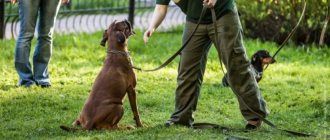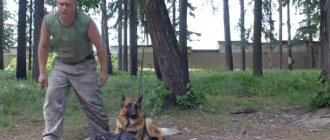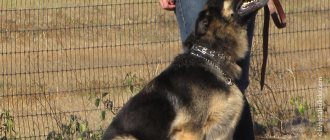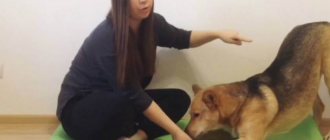You want to start training your dog, but don't know where to start. You understand that dog breeding must be learned in practice and in theory. Our article will help you take the first steps of a conscious dog owner; it will tell you how to teach your dog the simplest command “Give me a paw!” and will help you and your ward take a few steps towards each other.
Everyone likes the ability of a dog to give a paw on command: owners, passers-by, family friends. This is not included in the basic training norm. But the dog’s charm level definitely increases. It’s rare that anyone can hold back a smile when a four-legged pet trustingly extends its paw.
Can all breeds give a paw?
If the dog is healthy and this movement does not cause him pain, then it is possible to train him. How long this will take depends on many factors.
Many believe that breed is the main factor in trainability in this process. Scientists give ratings of dogs that are genetically tuned to training. They are probably right about something.
In such a dog school, poodles, retrievers, and German shepherds are among the top students.
I would also add “door terriers”. Among the mongrel brethren there are often very smart individuals. But in the gallery there are such “unheard” representatives of breeds as the Afghan Shepherd, Basset Hounds, Mastiffs and Pekingese.
Personally, I have been living with just such an “unteachable” person for the last 12 years. From personal experience I can say: do not rush to label your dog just because he is on the list of difficult to train breeds. If there is a desire to teach at least some command, then it will be fulfilled. The “Give me a paw” command is one of the simplest.
How to teach a dog the command “Give me your paw” if he doesn’t want to pick it up on his own?
Sometimes the puppy doesn’t want to get the treat with his paw. Trying to get to him with his teeth. In this case, try rote learning.
Say: “Give me your paw!”, take the puppy by the paw and help him reach your hand. It’s better not to pull his paw, but just push him with light tickling movements.
Give him the treat and repeat the exercise again.
Praise when the dog has just made an attempt to lift his paw off the floor. Don't wait for her to lift it all the way.
The baby will quickly understand how to get the treat and begin to lift his paw on his own.
You can lightly pat his paw at first, gradually reducing your interference. When your pet raises its paw, give the treat. And joyfully praise him: “Yes! Fine!".
Positive reinforcement in learning: Photo
Are all dog owners able to teach their pet commands?
I can definitely say that everyone can do it. The question is whether everyone will want it.
It often happens that novice dog breeders make mistakes in training. There is no understanding between man and animal, and everything goes wrong.
This situation is completely normal. Dog breeding needs to be learned both in practice and in theory. It can and should be corrected by seeking the help of a dog handler.
My Pekingese and I took several lessons. Believe me, it was worth the time and money. The level of respect my proud “little lion” has for his owner has noticeably increased.
And I was not alone in my search: in our group, along with shepherds and Rottweilers, Pekingese and dachshunds were engaged. And for each dog the lessons were beneficial. Highly recommend.
Such classes give the main thing: you will learn to understand each other. And without that, there can be no talk of any training. Even the smartest dog will seem like a stupid, harmful beast to you.
Why is comprehensive training and the “Give Paw” command needed?
Raising a dog begins with simple rules of behavior. The puppy is accustomed to a schedule of walking and feeding. The baby needs to be explained how to behave indoors and outdoors. There are several principles, following which, the owner can more easily cope with his pet.
- Firstly , the dog is not allowed into the bed, nor is it allowed to play or sleep on the furniture. There is a sun lounger - this is a place for the animal.
- Secondly , members of the household always eat first, after which the owner feeds the pet so that it can see that the food comes from the hands of a person. The larger the breed, the more important it is to develop tolerance and willpower. The dog should not take food from someone else's hands, beg, or steal.
- The third principle is that a person always enters the house first; this will help the pet recognize the owner’s leadership.
During the training process, discipline is instilled in the animal. A trained animal will never bark, attack, or growl for no reason; bother, whine, howl; destroy the house, mark the corners.
The list of basic recommended commands for any breed includes voice signals: “Sit”, “Lie down”, “Place”, “Voice”, “No”, “Give me a paw”. As each of them is studied, additional recognition signs are introduced: whistles, claps, movements. First of all, for ordinary domestic dogs, training helps to establish contact with a person. When the owner and the animal understand each other and feel each other on an emotional level, a real strong friendship develops.
The second positive side of regular training is discipline. The more signals a dog knows, the easier it is to control it. The better he understands the commands, the faster he will react in an emergency situation. This skill is necessary for all animals that are walked without a leash on the city streets (to stop in time in front of the road and throw garbage out of their mouths).
All hunting and service dogs are given to experienced dog handlers, because it is especially important for them to quickly grasp orders and carry them out. For regular education, you can also resort to the help of a kennel club.
Training: teach or force?
It's probably clear what we're talking about. What style of behavior to choose when you start a lesson. Someone adheres to totalitarian behavior, someone is ready to tolerate careless treatment of themselves, just not to be a rude dictator.
I am against dictatorship, but anarchy and a dog won’t work either.
A dog is a herd animal, so it obeys its leader. For her to recognize the main thing in you, a certain fortitude is required. But at the same time, with kicks, pokes and constant yelling, you can achieve only one thing: the dog turns into a frightened, intimidated animal with its tail between its legs.
In addition, from experience I can say for sure: not a single blow, accidental or intentional, will pass without a trace.
It will affect the return, and then you will be at the veterinarians. The expression “take care of your health from a young age” also applies to dogs. But you shouldn’t cooze with your dog, even if it’s a Pekingese, as in my case. The case is very difficult.
My little cute dog has reminded me more than once that he is blue, of royal blood, and not some trained poodle. If he wants, he does it. He doesn’t want to, turn his face to the side, and at least hurt himself! I was looking for options. Found it! More than anything in the world, my Senechka is afraid that he will be left, abandoned.
When disobedience went beyond all limits, I left the leash on the ground and pretended to leave. A minute later he was running to me, reprimanding me and almost crying.
For a week or two after that he was the most obedient dog. But I didn’t want to abuse this method. And it doesn’t apply to all dogs. Find your lever.
Tips to help you consolidate your skills
Teaching a Labrador puppy to give a paw is easier than developing this skill in small toy dogs. But over time, training will give results in any case. To maintain them, you need to gradually complicate the exercise.
The list of possible complications is as follows:
- Teach your dog to distinguish his right paw from his left using different commands. In the pet’s mind, the command “Give me a paw” should be assigned to one, and the command “Give me another” to the second;
- Try teaching your dog to extend his paw from different positions. Ideally, he should be able to do this while sitting, standing and lying down. But do not demand the impossible from the animal, for example, dwarf dogs have difficulty giving a paw when they lie down;
- You can go the opposite way - teach the animal to extend its paw when you yourself are lying, sitting or standing. However, here again it is necessary to make allowances for the pet’s height at the withers;
- Use not only your hand as a support for the paw, but also your knee and foot. At the last stages of mastering the command, you can even teach your pet to hold its paw in the air for several seconds.
At each of these stages of reinforcing the command, you need to support the dog, show it that it is acting correctly and that you are happy with it. If an adult is undergoing training, you can do without reward in the form of treats. If a small puppy is learning, be sure to give him treats for mastering all the described complications of the “Give a paw” command.
And under no circumstances should you force your dog to perform tricks when he is hungry, in a bad mood, or suffering from any illness. Firstly, such study will be unproductive. Secondly, your four-legged friend may lose motivation to learn commands.
Expert opinion
Kuzmenko Olga Olegovna
Information about the expert
Ask a Question
You need to carefully ensure that your pet does not overeat during training. If he gets full quickly, he won’t have any desire to continue studying.”
Where to start learning?
For the dog to understand what is wanted from it, let it know that the lesson has begun. That is, make her listen to the person’s words. The animal's learning begins with the development of concentration.
It is necessary to make eye contact. Place him opposite you, and, if possible, take a position at the same level. That is, sit on your knees in front of the dog.
At first, the dog, especially in puppyhood, will be constantly distracted. It is more interesting for her to run after a toy, roll over on her back in the hope of begging for a belly scratch. But we need to let her know that work has begun.
Reward the dog for sitting for a long time, for the fact that for some time he follows your gaze and listens to your speech. This is the first lesson. But don't drag it out.
When to start training
They start training no earlier than 3 months of age, but preferably at 4–5 months. Until this time, the puppy is too busy with games and quite confused. However, it is possible to master the team at any age, the main thing is that training should be regular.
Executing the command “Give me a paw” solves several problems:
- socialization - the dog becomes almost equal to the person and feels its importance;
- development of the animal’s logical abilities;
- improving motor skills - this is facilitated by exercises with the front/hind paws.
Once the puppy has learned to give his paw on command, continue to reinforce the skill without taking breaks (sometimes the pet forgets the lessons learned even after 2-3 days). To ensure that the command is imprinted in the dog’s memory, repeat it at least 3 times a day.
Return to content
Step by step learning methods
For a tasty treat and for affection - this is the basis of team training. You can use treats and approval as rewards.
Puppy
From the age of three months, the puppy is just getting acquainted with the world, getting to know it, and learning basic skills. There is no point in demanding more from him. If during this period he lives with his mother, then the process of education is easier. He will definitely copy her behavior. And if a parent knows how to execute the command “Give me your paw!”, then teaching this to your son or daughter will be much easier.
If the baby has already been taken away from its mother, then all hope lies with the owner, how competently he will behave, how subtly he will feel and understand his pet.
Adult
If the dog is smart and quick-witted, then you can start teaching commands as early as 4 months. It will not be too late to teach the command “Give me your paw” to a dog aged 3-4 years.
The older the dog gets, the longer the training period will be. But even in old age, the dog will try to understand the owner’s desire if there is a warm, friendly relationship between them. In the eyes of such a dog one can simply read the desire to somehow please his owner.
Small breed
I can’t say that raising small dogs is more difficult than raising large ones. It’s just that the owners pay little attention to their training. If the owners of such serious breeds as a shepherd, Rottweiler and other large dogs are simply forced to teach at least basic commands, then cute companion dogs often easily avoid lessons.
Knowing the power of their charm, they skillfully use it. But if the goal is set, these dogs are also trainable. As a rule, they are smart, artistic, and love the attention of both their owners and strangers. This is where you can play.
The difference in training success is caused not so much by breed as by temperament. Some are lazy and difficult to force to follow a command. Others are so fidgety that you need to be patient to get them to listen to their owner.
A few rules: for learning and consolidation
When training your pet, consider the basic recommendations. They will allow you to achieve success much faster and easier. What dog experts advise:
- The success of classes largely depends on a positive, friendly attitude, when the owner shows due persistence, while remaining kind and calm.
- Exercises are carried out when the pet is in a good mood, alert and healthy. If something is bothering the puppy—he doesn’t feel well, he’s tired—it will be difficult to achieve a positive result. In addition, he may develop a negative attitude towards classes.
- During training there should be no distractions or external irritants. The command “Give me your paw” can easily be practiced at home.
- Proper preparation for classes is the key to excellent and quick results. Never feed your puppy immediately before a lesson: it is better to do it two hours earlier, otherwise he will not be motivated by the treat. Tasty pieces should not be too large, otherwise the dog will quickly get full and lose interest in the activity.
- It is not necessary to use non-basic commands in the standard form. You can modify the order form. So, some dog breeders use the “High Five!” signal. The main thing is that the dog understands this signal and executes it correctly.
- Once you have chosen the wording of a command, do not change it. “Give me your paw” and “Give me your paw” sound completely different to a dog.
To develop skills, it is important to conduct classes systematically, but without driving the dog (this is not a machine), but correctly alternating training and rest breaks. Five to six repetitions per day is enough.
Training with treats
Favorite food will help you quickly master the command. Convenient when the dog loves dry food. Then the goodies don’t get your hands dirty and don’t crumble into small crumbs. The dog quickly eats them and wants more.
It’s more difficult when the dog eats natural food. It is better to immediately eliminate rewards with sugar. You don’t wish your pet harm.
You can use dry meat and small crackers. In my case it was pieces of bread.
This is also very harmful: baking is not good for the dog. But my justification can be the difficulties with this breed.
Attention, before choosing a treat, make sure that the dog is not allergic to this product.
Senya turned out to be a great baker. He is ready to do a lot for baking. He has no such love for meat. If you eat meat from a bowl, then this is a special gift to the owner, a kind of favor. He even stood on his hind legs for a freshly baked bun! I also learned to give a paw.
If the dog has a simpler character, then I would advise teaching the command with verbal encouragement. Then the animal will not be tempted to speculate on the acquired skill and beg for food, giving a paw when not asked.
The mongrels who used to live in our family did not know that a paw could get something tasty. They always gave a paw, with pleasure, and many times: one, another, two at once!
Their teaching was casual, not serious. But they figured it out quickly. If only they would take their paw and pet them for this!
The algorithm for training for a tasty treat is simple:
- Hold the treat in your hand and let your dog sniff it.
- She may begin to unclench her palm, shake her hand, or pry it with her nose. Then he touches it with his paw. This is the moment when you need to encourage her.
- Give a treat and praise.
- Repeat several times.
It may happen that the dog understands everything from the first lesson. Maybe even the second time she won’t understand that he wants her as her owner.
Let the lessons not be drawn out. Still, the main thing in communicating with dogs is joy. That's why we take them. Don't be nervous if things don't work out. Give the animal time to figure it out.
General rules for self-training a dog
By properly raising and training a dog, the owner becomes for it the most important creature in the world, a source of emotions and new knowledge. Such trust is priceless. The better you cope with the role of leader, the more successful your further training will be. How to teach a dog to give paw? You will need desire, time, patience and our advice from a professional dog handler .
Calm, just calm
- The main instrument of influence is the voice . The command is given in an even, calm tone, each with its own intonation. The dog does not yet understand your words literally, but reacts to the sound.
- Never yell at your dog. You can’t take your irritation out on her if something doesn’t work out at all. The dog will become isolated and will only work worse. It is the tone that affects, not the volume. Severity and anger are two different things.
- You cannot hit a dog for not following commands! Your four-legged friend should respect you, not fear you. Doesn't obey? You are making a mistake somewhere. The main credo of proper training is persistence without violence.
- You can give the same command no more than twice . The demand has been made - achieve its fulfillment. You are much more cunning and smarter than your pet. Careful observation of the animal will help you choose the appropriate tactics.
- Undesirable behavior is stopped using safe words (no, bad), spoken calmly but sternly.
A kind word pleases the dog too
- Praise from the bottom of your heart for correct behavior even in small things. Come up with a few “reward markers” (well done, good, bravo).
- You should not pat the animal on the head or ruffle the dog. Some four-legged students perceive rough petting as violence.
- The lesson should end on a positive note. For example, by following a favorite, well-practiced command and sincere encouragement from the owner.
- Always have a treat on hand. Don’t be afraid that the dog will start to cheat and work only for treats. The need for food rewards will disappear over time. The treat is given immediately after the order is completed, along with praise. It is advisable to pronounce the command so that the dog understands why he is being praised (“okay, give me your paw, okay”).
Not a moment of peace
- Before starting work, let the animal run around a little. Alternate training and “unloading”. We worked, played or walked. The dog should not get tired from training. If you notice that your pet has become distracted and has difficulty concentrating, it’s time to end it.
- Training should be approached in stages (mastered one technique, proceed to the next). A new element is introduced after familiar ones have been practiced, but not at the very end of the lesson.
- To increase motivation , older dogs are trained 6-8 hours after feeding. But the main criterion is that the pet must be actively interested in receiving the treat.
- Show kindness and energy. If you start exercising without desire or in a bad mood, your dog will feel the same.
- By training a dog from time to time, you run the risk that it will obey you sporadically: when it wants. Only repeated repetitions form stable skills. Communicate with your pet as much as possible. You will not regret it and as a result you will get a four-legged friend who understands everything perfectly.
Training without treats
- Getting the dog ready to work.
- We give the command.
- We touch the paw. If she doesn’t give it to her, we ourselves take the paw into our palm.
- We actively praise.
- We repeat several times.
The right attitude at the beginning of the lesson is important. The dog has calmed down, is not eager to escape, and looks into the eyes of his trainer.
An experienced dog handler, that is, you, gives the command “Give me your paw,” touches the paw with your hand, takes it in your hand and encourages it with words and voice: “Well done!” Release your paw and repeat again.
Until you and the dog get tired of it. That is, a minute or two, no more. Then cuddle toys and work again. Three approaches are the optimal training regime for amateurs.
And we are already adults
Traditionally, training in the “give paw” command begins when the puppy approaches six months of age, however, with a strong desire on the part of the dog breeder and expressed abilities on the part of the pet, the training process can be somewhat accelerated. A four-legged baby at 2-3 months old is a quite suitable candidate for the adult position of paw giver.
Learning from other dogs
The ability to imitate is inherent in man's best friend. If used skillfully, it can make training easier. This is possible in a group lesson with a dog handler.
By watching how other dogs carry out the command, yours will quickly understand what exactly they want from it. If your pet has a friend they play with on walks, ask if they know how to give paws.
If you are lucky and your partner has already mastered this command, then all you have to do is ask for a master class. I am sure that it will be fun and productive.
Exercises to consolidate knowledge
Exercises to consolidate results are also of great importance for the effectiveness of memorization and the development of discipline. In everyday life, you can periodically ask your dog to give him a paw.
For example, you can ask your pet to give a paw in the morning after waking up. During the game, you can also repeat the training by being friendly. There may be several such moments during the day. This is the only way to quickly and effectively train a student.
Additional Information. There is no need to demand that actions be repeated every half hour, as this can irritate the ward.
You can teach your pet to give a paw on your own, or by sending it to a group where professional training will be provided. In this case, you need to choose a suitable training method and take into account the abilities of the ward. The main thing to remember is that your pet needs to be loved and encouraged in every possible way. You cannot show aggression and punish the dog for misdeeds. Then the dog will definitely be able to learn anything.
Conditions for preparing for training
To ensure that the training lesson is more effective, the dog is not distracted, but is energetic, follow several conditions.
Do not feed your pet 30 minutes before the start of the lesson. Immediately after eating he wants to sleep. Plus, treats taste better on an incomplete stomach.
No more than an hour should have passed since the last walk. The dog has already rested after walking, but has not yet accumulated energy that requires release.
Especially young dogs learn more easily a lesson that takes place in the form of a game. Play with it before and after class. Both will enjoy it. And the dog will treat the next lesson more favorably.
Recommendations for training
The owner of an animal should always remember basic tips that will greatly simplify training:
- If your pet (especially a young puppy) shows signs of fatigue, hunger or anxiety, exercise should be postponed until his health improves.
- A person who is in a bad mood should not take up raising an animal, because activities aggravated by the owner’s irritation will not bear fruit. Dog handlers also categorically prohibit punishing four-legged pets with screams, beatings and other torture.
- The most common form of command can actually be modified in different ways depending on what the dog learns best. Sometimes owners try to use even such an atypical phrase in this case as “High five!”
- To achieve joint success, you need to maintain regularity in training, and also not diminish the role of at least 30-minute breaks between classes.
- 5-6 repetitions per day are enough. However, if the animal begins to get nervous or whine, the lesson is interrupted until the next day. The dog may not have the desire to exercise at all - then you should not force it to do so.
- It is better to carry out training in a quiet, home environment, when there are no distractions nearby. If there is no quiet corner, in the warm season you can go to the fresh air - to a park or forest. It is necessary that there are not too many people in the chosen place.
If you master the basic command, you can move on to complicate it, for example, pronounce the task faster, ask for a paw from a dog in a lying or standing position, substitute not your hand for support, but your foot, knee, or do not substitute anything. Holding the limbs in the air will have a beneficial effect on the development of the animal’s motor skills.
After just 1-2 weeks of systematic exercise, the pet will perfectly master the new skill and will be able to please its owner.
Possible mistakes
If something goes wrong, find the reason for it. You are just a beginner trainer.
If the dog stubbornly avoids training, hides, looks scared, then you have clearly gone too far. Even if the pet was not physically punished, he felt that he could not please the owner and was experiencing great stress about this.
This behavior will be corrected by affection and attention. You can even give up classes for a while. Returning to them, move in small steps and encourage the dog for every obedience.
The dog carries out the command casually, slightly raises its paw and immediately removes it, distracted. Show persistence and perseverance.
The dog should receive treats and approval only if the command is clearly executed: give his paw and hold it for a few seconds.
The dog has learned to give its paw: what next?
There are as many methods of training and types of tricks as a trainer can come up with. If you are interested in further developing the skills of a four-legged artist, we advise you to learn other interesting elements, the basis for which is the simple ability to give a paw.
- “high five” - raising its paw high, the dog touches the owner’s open palm with it;
- “give both” - the dog gives both paws at the same time;
- “ladushki” is a funny element that imitates a child’s game;
- “hold” - after raising the paw, the animal keeps it suspended;
- “Give me the back” is not the most convenient trick for a dog to perform from a standing position;
- “Spanish step” - the tailed comrade strides, raising his front paws high. It's hard to believe that performing this difficult element of freestyle (dancing with dogs) is impossible without the ability to give a paw. But, who knows, maybe your pet will become a star not only in a narrow family circle, but also at prestigious sporting competitions?
Briefly about the main thing
- The “Give Paw” command can be taught to almost any dog, regardless of breed and age. Every owner can do this.
- The training process will bring you closer to your pet. You will look at your dog differently.
- If the command is mastered, you can consider yourself an experienced dog owner who understands the psychology of his ward and occupies a leading position in the “Human-Animal” tandem.
- The “Give me a paw” command is one of the first in the dog’s training process. Sometimes she becomes the only one.
- From time immemorial, dog breeders have been teaching this trick to their four-legged friends. This establishes trust between man and animal and evokes a whole range of positive emotions.
- Having learned this command, the dog does not forget about it all his life.
Did you like the article? Share it with your friends on social media. networks. This will help them get useful information and support our project.
How will such a trick be useful?
Despite the fact that the order seems unnecessary and in no way applicable from a practical point of view, in reality this turns out to be not entirely true. It is more convenient for the owner of a dog who knows how to perform such an action to wash his pet upon returning from the street or trim his claws. In addition, the training process itself educates the animal and has a beneficial effect on its logical thinking.
Regardless of whether the training takes place in a special group under the supervision of a trainer or is carried out by the owner himself within the walls of the house, the exercise must be repeated regularly, and so that the animal feels team spirit and calm.
Instructions for training first skills
When a puppy appears in the house, its upbringing begins immediately. Of course, you cannot constantly give an inhibitory command, unless, of course, the owner wants to get a neurotic dog in the future. But some rules of behavior (not to confuse raising a puppy with training a puppy at home) must be instilled in the animal from the very first days, regardless of the breed of the baby, be it a charming dachshund or a handsome Great Dane.
As many future owners know, you cannot walk your pet until the second vaccination. The first is often done by the breeder, the second by the owner. But the baby goes to the toilet, will the whole apartment really turn into a springboard for dog waste? Nothing of the kind, the owner just needs to teach the pet to do its business in the diaper.
Note! Disposable diapers for animals are sold in all pet stores; they are quite cheap and economical to use. So, barely noticing how the puppy is restlessly marking time, trying to choose a secluded corner for his needs, the owner carefully picks him up, carries him to the diaper, sits him down, strokes him and says “here”, “business”, etc.
After a husky, mistakenly called a husky by the people, a pug or a chow-chow, as well as a puppy of any other breed, has done its business, it is praised and treated to something tasty. Within normal limits, of course, the treat should be one sip
So, barely noticing how the puppy is restlessly marking time, trying to choose a secluded corner for his needs, the owner carefully picks him up, carries him to a diaper, sits him down, strokes him and says “here”, “business”, etc. After that As a husky, mistakenly called a husky by the people, a pug or a chow-chow, as well as a puppy of any other breed, has done its business, it is praised and treated to something tasty. Within normal limits, of course, the treat should be one sip.
The owner must act in this way until the puppy learns to run on its own in the diaper, having felt certain calls from the body.
Now it remains to consider the problem of the pet walking throughout the apartment. Some people allow the baby to move around the house, while others don’t want this at all. Therefore, from the first days of a puppy in the house, he is taught to move only in a certain area, for example, in the hallway and in the kitchen.
If the owner entered the room, and his corgi, Doberman or Akita Inu ran in after him, the actions are as follows:
- They take the baby in their arms.
- They are taken out of the room.
- Place it at the entrance so that the pet can see the owner.
- They say the command “wait”.
- They enter the room for a few seconds.
- They go out to the puppy, praise him and encourage him.
A pet trained in this way will wait for the owner not only in the house, but also at the door of a store, for example. Although it is not recommended to leave the animal outside without the supervision of the owner unless absolutely necessary. You can go shopping without a dog, you never know how many inappropriate people there are around. Representatives of small breeds are especially often stolen, but large dogs are also taken away from store doors.
Ideally, the pet should also have its own house where it can relax without outside interference. Today, special dog cages and boxes are popular; they can be seen in the photo below.
Boxing for dogs
The dog feels comfortable and cozy in such a “pen,” although a lot depends on the breed of the pet. It is unlikely that Yorkies, being rather shy dogs, will be happy in a confined space. But larger and more balanced representatives of a particular breed, for example, Labradors, will simply be happy to be alone with themselves.
Stages of accustoming a puppy to a bed (box, crate, kennel):
- First you need to put a treat in the box so that your pet can see it.
- Then the word “box” or “place” is pronounced and the puppy is shown the direction with his hand.
- When the dog enters the kennel (box, cage), the door closes. When he eats the treat, praise your pet and after 3-5 seconds. release into the wild.
- The time the dog stays in the box increases by 1-2 seconds every day. When the puppy learns to be calm in a confined space, you can slowly begin to leave your pet alone.
And finally, training to use a collar and leash. This should be done from the first days of the baby’s stay in the house. The owner simply puts the collar on him for a few seconds at first, gradually increasing the time. If the animal reacts calmly to a foreign object on its neck, it is praised and treated to something tasty.
Note! The main thing is to take into account the breed of the puppy. Some immediately get used to the collar, being strong and with a stable psyche (Laika, as an option), while others try to faint as soon as they feel it on their neck
The owner must act delicately, wisely, without morally violating the pet.
Walking on a leash
Problems and behavior when checking
One common problem is a dog that won't put its paw on your hand, no matter how long you try to entice it with a treat. In this case, move the hand holding the treat closer to the dog's paw. You can even give your leg or paw a little push. As soon as your dog puts his paw in your hand, give him a treat and say “okay” or press the clicker.
If your dog still doesn't understand what is expected of him after you push his paw, you can try lifting his paw into your hand. Give the "give paw" command, reach down and grab the paw, and then tell your dog "okay" or click the clicker and offer a treat.
Repeat this quickly several times in a row, giving your dog a treat each time, and then go back and start from the first step above. Most dogs will now understand what is expected and will begin to offer their paw.
Remember to be patient and keep your workouts short. If your dog is upset or bored, it's time to end the session. Always try to end on a positive note, even if that means asking your dog to do something as simple as sit.
When your dog regularly shakes with you, it's time to prove your behavior. The best way to do this is to ask the dog to shake the dog. The more familiar your dog is with this person, the easier this will be.
Demonstrate your approach to the dog first so that the person can imitate you as closely as possible. Then let that person sit the dog down and ask him to shake it.
Try this with a few people and your dog will learn that people love to shake their paws! Then, once your dog learns to shake, you can move on to teaching him to wave his paw.
How to teach a dog to give paw: three main ways
When the goal is achieved, start the lesson. To teach your dog a command, we recommend using one of the presented methods of your choice.
With a treat
If the order of actions is followed exactly, teach the dog the command “Give me your paw!” maybe in a couple of lessons.
To practice the skill, the exercise must be repeated several times so that the pet develops a connection “command - lifting the paw - reward”.
No treats
This method is also called mechanical. It is suitable for active puppies and adult dogs:
Mastering the skill using this method will take a little longer, but you will be able to evaluate your pet’s controllability, intelligence and tractability.
Why is this command needed?
Mastering the command will be useful in everyday life, for example, when caring for claws, washing paws, putting on shoes, and will help strengthen the emotional contact between the owner and the pet.
To consolidate a skill, it must be repeated regularly. This is not difficult to do, since you do not need to go for a walk to carry out the command. Just remember to ask your pet for a paw, and then he will remember it for the rest of his life.
Rules for conducting a training program
In upbringing, the owner needs to show firmness, but restraint. It is unacceptable to use harsh words or apply physical force. Professionals recommend adhering to the basic rules necessary for any training program:
I recommend: Dog kennel: requirements, types, construction techniques
Praise needed:
- firstly, the tone changes to friendly;
- secondly, soft, affectionate words are used;
- thirdly, a portion of treats is given.
Necessary commands to control a dog in the city
Constantly in contact with social society, it is necessary to be confident in the dog’s skills, especially for owners of “potentially dangerous breeds”. At the moment there is a special canine course called UGS (controlled city dog), it is often confused with OKD (general training course), but these are two completely different standards. Training in the UGS course is divided into two stages - at the training site and in the city.
First stage (on site):
- Moving next to the handler on a leash;
- Movement nearby by a trainer without equipment;
- Landing the dog from movement;
- Styling the pet with restraint and recall;
- Styling in the presence of distractions.
Second stage (in the city):
- Meeting a dog with people;
- Meeting the bike;
- Animal's reaction to a car;
- Behavior when meeting runners (roller skaters);
- Actions when seeing other dogs;
- The reaction of a pet left on a leash towards others.
The main part of the skills is related to the socialization of the animal, which suggests that social adaptation in the city is even more important than following commands.











